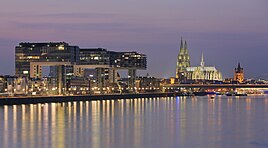
Back Keulen Afrikaans Köln ALS ኮልን Amharic Colonia (Alemanya) AN Coln ANG كولونيا Arabic كولونيا ARZ Colonia (Alemaña) AST Köln Azerbaijani کولن AZB
Cologne
| |
|---|---|
|
| |
| Coordinates: 50°56′11″N 6°57′10″E / 50.93639°N 6.95278°E | |
| Country | Germany |
| State | North Rhine-Westphalia |
| Admin. region | Cologne |
| District | Urban district |
| Founded | 38 BCE |
| Government | |
| • Lord mayor (2020–25) | Henriette Reker[1] (Ind.) |
| Area | |
| • City | 405.15 km2 (156.43 sq mi) |
| Elevation | 37 m (121 ft) |
| Population (2022-12-31)[2] | |
| • City | 1,084,831 |
| • Density | 2,700/km2 (6,900/sq mi) |
| • Urban | 3,500,000 (Cologne Bonn) |
| • Metro | 8,711,712 (Rhineland) |
| Time zone | UTC+01:00 (CET) |
| • Summer (DST) | UTC+02:00 (CEST) |
| Postal codes | 50441–51149 |
| Dialling codes | 0221, 02203 (Porz) |
| Vehicle registration | K |
| Website | stadt-koeln.de |
Cologne (/kəˈloʊn/ ⓘ kə-LOHN; German: Köln [kœln] ⓘ; Kölsch: Kölle [ˈkœlə] ⓘ) is the largest city of the German state of North Rhine-Westphalia and the fourth-most populous city of Germany with nearly 1.1 million inhabitants in the city proper and over 3.1 million people in the Cologne Bonn urban region. Cologne is also part of the Rhine-Ruhr metropolitan region, the second biggest metropolitan region by GDP in the European Union. Centered on the left (west) bank of the Rhine, Cologne is about 35 km (22 mi) southeast of the North Rhine-Westphalia state capital Düsseldorf and 25 km (16 mi) northwest of Bonn, the former capital of West Germany.
The city's medieval Cologne Cathedral (Kölner Dom) was the world's tallest building 1880–1890 and is today the third-tallest church and tallest cathedral in the world. It was constructed to house the Shrine of the Three Kings and is a globally recognized landmark and one of the most visited sights and pilgrimage destinations in Europe. The cityscape is further shaped by the Twelve Romanesque churches of Cologne. Cologne is famous for Eau de Cologne, which has been produced in the city since 1709; "cologne" has since come to be a generic term.
Cologne was founded and established in Germanic Ubii territory in the 1st century CE as the Roman Colonia Agrippina, hence its name.[3] Agrippina was later dropped (except in Latin), and Colonia became the name of the city in its own right, which developed into modern German as Köln. Cologne, the French version of the city's name, has become standard in English as well. Cologne functioned as the capital of the Roman province of Germania Inferior and as the headquarters of the Roman military in the region until occupied by the Franks in 462. During the Middle Ages the city flourished as being located on one of the most important major trade routes between east and western Europe (including the Brabant Road, Via Regia and Publica). Cologne was a free imperial city of the Holy Roman Empire and one of the major members of the trade union Hanseatic League. It was one of the largest European cities in medieval and renaissance times.
Prior to World War II, the city had undergone occupations by the French (1794–1815) and the British (1918–1926), and was part of Prussia beginning in 1815. Cologne was one of the most heavily bombed cities in Germany during World War II.[4] The bombing reduced the population by 93% mainly due to evacuation, and destroyed around 80% of the millennia-old city center. The post-war rebuilding has resulted in a mixed cityscape, restoring most major historic landmarks like city gates and churches (31 of them being Romanesque). The city boasts around 9,000 historic buildings.[5]
Cologne is a major cultural center for the Rhineland; it hosts more than 30 museums and hundreds of galleries. There are many institutions of higher education, most notably the University of Cologne, one of Europe's oldest and largest universities;[6] the Technical University of Cologne, Germany's largest university of applied sciences; and the German Sport University Cologne. It hosts three Max Planck science institutes and is a major research hub for the aerospace industry, with the German Aerospace Center and the European Astronaut Centre headquarters. Lufthansa, Europe's largest airline,[7][8] have their main corporate headquarters in Cologne. It also has a significant chemical and automobile industry. Cologne Bonn Airport is a regional hub, the main airport for the region being Düsseldorf Airport. The Cologne Trade Fair hosts a number of trade shows.
- ^ Wahlergebnisse in NRW Kommunalwahlen 2020 Archived 17 May 2022 at the Wayback Machine, Land Nordrhein-Westfalen, accessed 19 June 2021.
- ^ "Bevölkerung der Gemeinden Nordrhein-Westfalens am 31. Dezember 2022 – Fortschreibung des Bevölkerungsstandes auf Basis des Zensus vom 9. Mai 2011" (in German). Landesbetrieb Information und Technik NRW. Retrieved 20 June 2023.
- ^ "From Ubii village to metropolis". City of Cologne. Archived from the original on 17 April 2012.
- ^ "bomber command – mines laid – flight august – 1946 – 1571 – Flight Archive". Archived from the original on 4 July 2019.
- ^ "Denkmalliste" [List of monuments]. Offene Daten Köln (in German). Retrieved 28 December 2023.
- ^ "Economy". KölnTourismus. Archived from the original on 1 August 2010. Retrieved 18 April 2011.
- ^ Pariona, Amber (25 April 2017). "The Largest Airlines in Europe". WorldAtlas. Archived from the original on 15 April 2021. Retrieved 29 August 2019.
- ^ "Lufthansa regains place as Europe's biggest airline from Ryanair". Reuters. 10 January 2018. Archived from the original on 5 December 2020. Retrieved 29 August 2019.
© MMXXIII Rich X Search. We shall prevail. All rights reserved. Rich X Search











